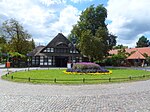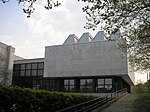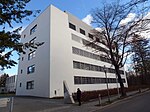Philological Library

The Philological Library (German: Philologische Bibliothek) is a component of the "Rust and Silver Lodges" complex in the main campus of the Freie Universität Berlin. It was designed by internationally known architect Norman Foster, Baron Foster of Thames Bank in the shape of a human brain, and opened in 2005. The library merges the separate smaller libraries of the departments and institutes of humanities and now contains: General and Comparative literature Byzantine/ Modern Greek studies English studies German studies Comparative and Indo-European Linguistics Classics Dutch Linguistics and Literature Indian Linguistics and Literature/ South Asian Studies Latin American Studies Medieval Latin Language and Literature Philosophy (since 2007) Romance studies Slavic studiesIt has become the centerpiece of the university's Dahlem campus and a Berlin architectural landmark.
Excerpt from the Wikipedia article Philological Library (License: CC BY-SA 3.0, Authors, Images).Philological Library
Habelschwerdter Allee, Berlin Dahlem
Geographical coordinates (GPS) Address External links Nearby Places Show on map
Geographical coordinates (GPS)
| Latitude | Longitude |
|---|---|
| N 52.451944444444 ° | E 13.288333333333 ° |
Address
Habelschwerdter Allee 45
14195 Berlin, Dahlem
Germany
Open on Google Maps









